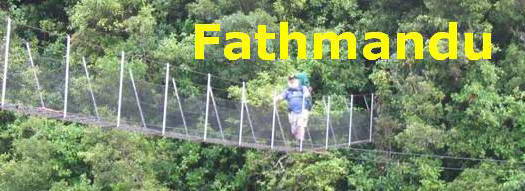
Many thanks for permission to use graphics from their software and toposheets |
 |
|
3 May 2007 Hātea River Walkpage 2
Alice takes five. Again, the positioning of the seat provides a pleasant view of the stream, but the m, m, and g again represent a threat to the state of one's trousers. Both picnic table and seat seem to have been provided according to some departmental formula rather than with real thought about where they might enjoy maximum patronage. A healthy looking young tawa is beginning its trek to the canopy and a young hangehange, front left, is also bursting with lush health, as in fact are nearly all the plants we encounter on the way through.
Fragrant fern (mokimoki) and rata neck and neck.
A wiry young mangemange casts about for something to climb. These can be seen in great hanging curtains at times and provided for early bushmen a handy mattress when stuffed inside a suitable bag. An exquisite fern frond hangs down from a mossy bank
Above us the bush is tall and luxuriant, and the track surface remains impeccable. Coprosma grandifolia, the big leaved coprosma. I still react to the size of these leaves on such a small plant, but many juveniles have large leaves compared with their adult forms, and these are by no means special. Elsewhere, adult trees are flowering right now, and display another quite common feature of many New Zealand natives: they are dioecious, which means that male and female flowers are on separate trees, often quite close together, and are wind-pollinated. As far as I know these are the only coprosmas to flower in autumn: the rest are typically spring flowering. The following couple of shots were taken elsewhere, but illustrate quite well. The female flowers are erect, the male drooping, for what it's worth.
A young totara finds a place beside the track. These are often absent in bush reserves unless specially planted, as they generally require a slightly more fertile soil than most. In fact, these and puriri are often useful indicators of soil fertility if they are present in numbers. Perhaps the path was constructed with more attention to detail than I suspected earlier in commenting on the seating.
Schefflera have an almost tropical look about them at times. Here's a young kohekohe, with a fallen tanekaha leaf resting on it. More boardwalk.
The climbing fern we saw earlier had an entire frond. As it grows older the fronds become pinnate. It is Microsorum scolopendrium, though most reference books have it listed under earlier names. Its Maori name is mokimoki. It also goes as Fragrant Fern, but I have never been able to detect anything especially fragrant about it. This is a filmy fern, one of the Hymenophyllum species, but I have never come remotely close to distinguishing the species in this largish genus. In dry weather these simply crisp up and wait for the rain.
This young nikau epitomises the lush and healthy growth along this track.
|
|